With a warm and wet summer, we are experiencing decline in some of our turf around the state due to temperatures, disease, insects, and weeds. In response, we are publishing a four part series on this topic to help turfgrass managers respond. Look forward to the following topics over the next two weeks.
Part I: Too hot: Why some turfgrass species look poor in summer.
Part II: Summer diseases in residential turf.
Part III: Summer weeds: Common summer weeds and their control.
Part IV: Summer insects: Monitoring for summer pests and preparing for fall.
Summer insects: Monitoring for summer pests and preparing for fall
Turfgrass insect pests capitalize on stressed turfgrass. Drought, floods, and temperature extremes not only affect the turfgrass growth and vigor, but also affect the insect pests that regularly occur there. Four main groups of insects can be considered key pests in turfgrass. While these groups include several species, each with its own biology and life history, some general information about these four groups may help a turfgrass manager monitor and control these pests.
Billbugs: Billbugs can infest and destroy a number of turfgrass varieties. Adult billbugs pass the winter and begin laying eggs in earnest during May. High larval populations can cause damage to the turfgrass by mid-June and may continue throughout the summer months. Billbug damage can be characterized by the occurrence of irregular patches of dead grass, especially near sidewalks or pathways. This damage appears similar to injury caused by a variety of other factors, thus must be confirmed through a close examination of the turfgrass. Pulling up some of the affected plants may show evidence of damage where the larvae have chewed through the crown. This feeding severs the stems from the roots and often is accompanied by resulting frass (sawdust-like material) as a sign that the weevils have been at work. Finding adult beetles crawling on the turfgrass or larvae in the thatch and upper layers of the soil is also good evidence that billbugs are active.
In zoysiagrass, a second generation of billbugs often occurs but treatment at this time is likely to be ineffective. We recommend waiting until next spring.
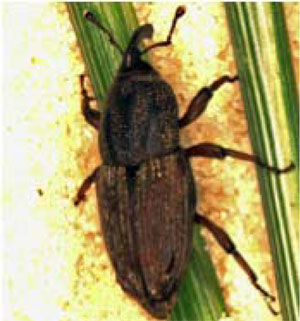
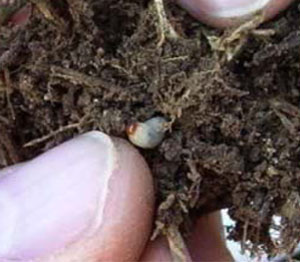
Sod webworms: Although many grass species are susceptible to sod webworm damage, bluegrass and bentgrass lawns are particularly vulnerable. Normally, 1st generation adult moths become active in late May or early June, eggs are laid, and the small spotted caterpillars feed on the soft leaf tissues between the veins in June and July. As they grow and mature, sod webworm caterpillars cut the blades at the thatch line, leaving areas of close-clipped grass. A second generation often occurs during the month of August. If sod webworm damage is suspected, it can be verified by drenching the turfgrass surface with a soapy water solution (1 Tbs liquid dishwashing soap/ gallon of water). Sprinkle this over a 2ft by 2ft area and watch for 10 minutes. If present, caterpillars will quickly come to the surface of the turfgrass. Repeating this process at several locations may provide evidence of the extent and severity of webworm infestations.
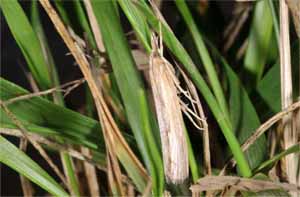
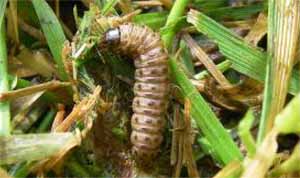
Photo 3 and 4
Black cutworm: Black cutworms are generally considered to be a pest of bentgrass greens on golf courses. On occasion, they can damage other turfgrass as well. Adult moths migrate north and arrive in Indiana any time from late winter through spring. There may be multiple generations of this pest and the caterpillars can be active in the turf throughout the summer. Black cutworms grow much larger than sod webworms and the amount of damage that they can create may also be greater, especially on stressed turfgrass. Black cutworms are similar in size to many different species of armyworms and cutworms, that can also infest turfgrass on occasion. Turfgrass managers should be on the look-out for any caterpillar that they see crawling on the grass. These should be identified and serve as a red flag that greater populations may be present. Monitoring for all caterpillars can be made easy with soap drenches as discussed for sod webworm monitoring.
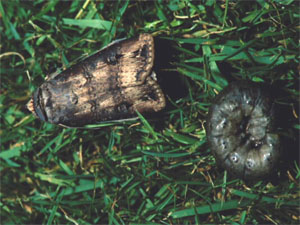
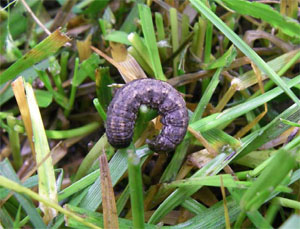
Annual White grubs: Two key grub pests in Indiana are the masked chafer and the Japanese beetle. These are referred to as annual white grubs because they have only one generation per year. Adult beetles usually emerge by late spring, mate, and lay eggs in the soil and the small grubs hatch in late July or early August. White grub activity was early this year due to the unseasonably warm temperatures in late winter and spring. As a result, some grub damage started earlier in the season than normal and late instar grubs are already present at damaging levels in some places across the state.
Grubs feed in the soil on organic material (including grass roots) that can result in dead patches of turfgrass. When excessive turfgrass damage occurs, the upper turf is actually disconnected from the root system so that it feels spongy when walked on and can be lifted up from the soil like carpet. It this point, damage is irreversible and turfgrass renovation will be required. Prior to that, however, turfgrass that has had a history of grub damage or turfgrass areas that begin to discolor and do not respond to irrigation should be inspected closely for grub populations. Digging into the turfgrass with a small shovel or hand trowel will provide evidence of active grub populations. Generally, if 7-10 grubs are found per square foot of turgrass, control options should be considered.
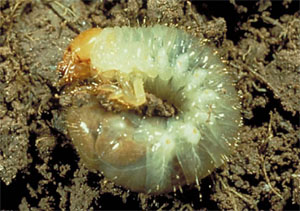
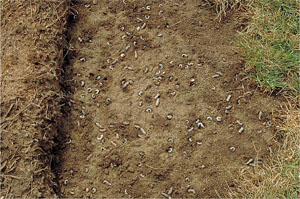
Chemical Control Options
Chemicals for control of turfgrass insect pests fall into several general groups. Some of the more commonly used products are listed below. Each should be selected based on the pest in question, the application site, time of year and the formulation of the product. For more detailed information consult the entomology e-series publications.
Pyrethroids (adult billbugs and caterpillars)
DeltaGard
Scimitar
Tempo
Talstar
Others
Spinosad (caterpillars)
Conserve
Carbamates (caterpillars)
Sevin
Oxadiazines (white grubs, billbug larvae and adults, caterpillars)
Provaunt
Neonicotinyls
Merit (billbugs, white grubs)
Arena (billbugs, white grubs, caterpillars)
Meridian (billbugs, white grubs, caterpillars)
Combinations (containing both neonicotinoids and pyrethroids)
Aloft (caterpillars, adult billbugs)
Allectus (caterpillars, adult billbugs)
IGR’s
Mach II (white grubs, billbugs, caterpillars)
Nematodes
S. carpocapsae (caterpillars, adult billbugs)
H. Bacteriophora (billbug larvae, white grubs)
Anthranilic Diamide (white grubs, caterpillars, billbugs)
chlorantraniliprole